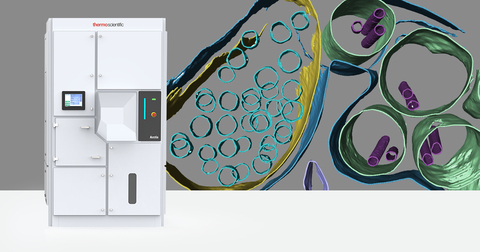HILLSBORO, Ore.– Thermo Fisher Scientific Inc., the world leader in serving science, today unveiled the Thermo Scientific Arctis Cryo-Plasma Focused Ion Beam (Cryo-PFIB), a new connected and automated microscope designed to advance the pace of cryo-electron tomography (cryo-ET) research.
Cryo-ET makes it possible to study how proteins and other molecules operate together in a cellular context, at resolutions unsurpassed by other microscopy techniques, and has enormous potential for cell biology research, including the study of infectious disease, neurodegenerative disease, and other globally impactful structural biology applications. However, the process of preparing optimal samples for cryo-ET is still time-consuming and complex.
The Arctis Cryo-PFIB helps users address these challenges with advanced automation and new connectivity capabilities within the workflow, significantly increasing throughput compared to other commercially available solutions for fast, reproducible production of samples for cryo-ET.
“Our goal is to provide an end-to-end cryo-ET workflow for new and experienced users,” said Trisha Rice, vice president and general manager of life sciences at Thermo Fisher. “By expanding our automation capabilities to our cryo-PFIB portfolio, we can pave the way for cryo-ET to become a frontier technique for cell biology.”
The system is designed to provide high-quality samples with consistent thickness while minimizing sample contamination risks. Users will benefit from integrated correlative microscopy, dedicated Plasma FIB technology, advanced automation and new connectivity capabilities, including simplified sample loading and transfer.
“Through a strategic effort with Thermo Fisher Scientific on the build of this innovative cryo-PFIB, we hope to increase—by a factor of ten—the number of biological specimens that can be prepared for analysis by structural biology, and pioneer large volume cryo-ET,” said Jim Naismith, director of The Rosalind Franklin Institute and collaborator in the development of the Thermo Scientific Arctis Cryo-PFIB.
Thermo Fisher Scientific and The Rosalind Franklin Institute began working together in 2019, using existing technology to understand and determine what’s next for cryo-EM, and where innovation would be needed to create the next generation of instrumentation.
“Our joint ambition to drive scientific and technological breakthroughs, and our goal of increasing access to cryo-EM to as many scientists as possible, make The Rosalind Franklin Institute and Thermo Fisher Scientific ideal collaborators,” added Naismith. “We will continue to work together to democratize the technique and create incremental yet impactful improvements to the workflow.”



